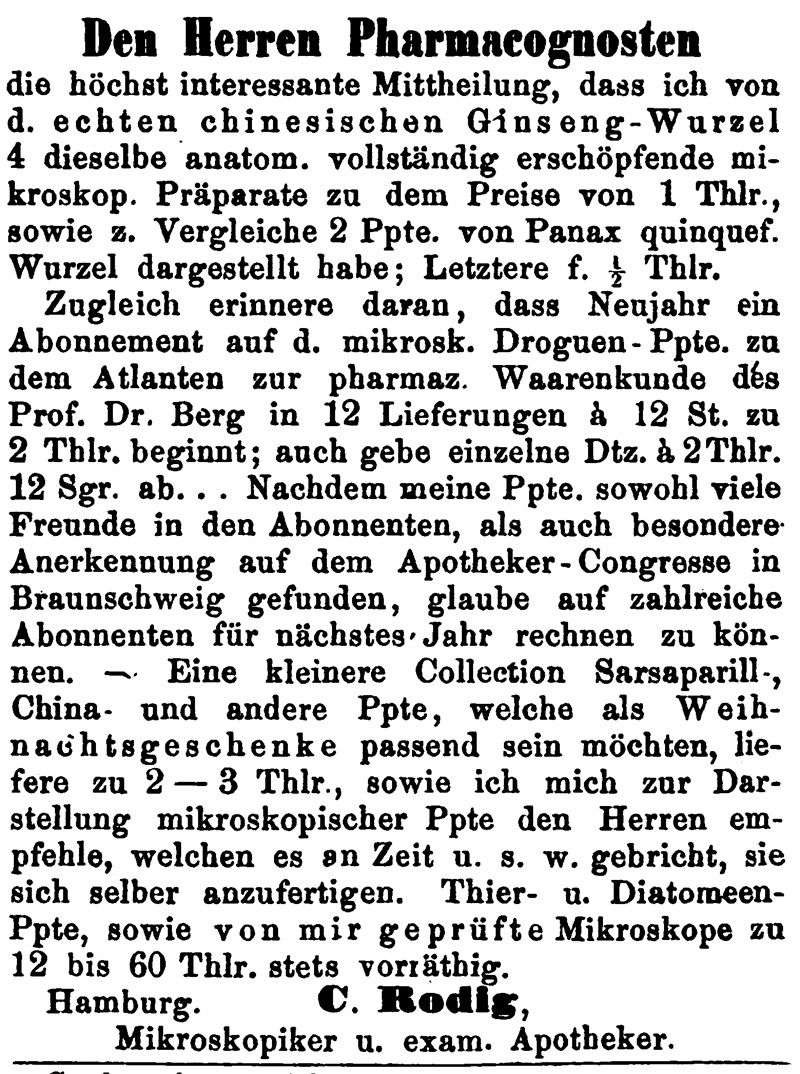Johann Carl August Rodig, (C. Rodig), 1834 - 1913
by Brian Stevenson
last updated October, 2013
Carl Rodig
was an apothecary (pharmacist/chemist), trained in the use of microscopy for
analysis of compounds. After opening his shop in 1865, he began selling
microscope slides of pharmaceutical plants and other items. Within a few years,
slides appear to have made up a considerable part of Rodig’s business, his
preparations being exported to England and the United States. Rodig probably made most of these slides himself. Several contemporaries considered Rodig’s slides of diatoms to be equal
in quality to those of J.D. Möller. Rodig also sold microscopes, most likely
produced by other people.

Figure 1. Microscope slides by C. Rodig, spanning his 1865-1913 career. All bear the same handwriting, presumably that of Rodig himself.
(A) These slides do not reference Rodig’s Vienna medal, and so date from between 1865 and 1873. The label on the upper slide gives Rodig’s first initial as “G” – this may have been a misprint, or he may have also used another first name. There are no known records of a 19th
century microscopist in Hamburg named G. Rodig.
(B) Various preparations dating between 1873 and 1880 (Rodig moved from Hamburg to Wandsbek in 1880). The white-labeled slide was dated 1875 by an owner. The larger slides are standard English 1x3 inch, while the smaller ones are 7/8 x 2 1/2 inches (22 x 64 mm).
(C) Post-1880 slides with the Wandsbek address (“Wandsbeck b/ Hamburg”). These slides note medals (“praemiirt”) awarded at both Vienna and Hamburg. The latter may have been the International Horticultural Exposition of 1897. Although Rodig’s label style was similar to those of other German slide-makers such as Moritz Hensoldt and Heinrich Boecker, there are no known business connections between Rodig and any of those professional mounters.
Carl Rodig
was born on April 23, 1834 in Cottbus, Brandenburg, which is approximately 75
miles (125km) southeast of Berlin. He was licensed as a microscopist apothecary
in Hamburg on February 13, 1865. The earliest known advertisement from Rodig
listed natural medicines such as ginseng and sarsaparilla, which he had tested
by microscopic examination (Figure 2). Rodig also conducted scientific
investigations, such as an 1868 study on a flour-like substance that had been
reported to be in egg yolks, but which Rodig concluded to be an artifact of
certain staining methods.

Figure 2. November, 1865 advertisement from Carl Rodig.

Figure 3.
Early advertisements offering microscope slides.
By 1867,
Rodig was specifically advertising sales of microscope slides (Figure 3A). His
advertisements indicated a very broad range of subject matter (Figure 3B).
He quickly
acquired a reputation for high quality slides, of various types of specimens.
In his 1869 Archiv fur Mikroskopische
Anatomie, Max Schultze described Rodig’s diatom preparations as “highly clean executions and good
preparations” that were equivalent to those of Möller and Bourgogne.
Schultze also described the preparations of trichina-infested animal tissues by
Rodig and Möller to both be “very
successful”. Heinrich Frey, in his 1872 Das
Mikroskop und die Mikroskopische Technik, stated that “J. D. Moller, of Wedel, Holstein, has recently produced a very
excellent but expensive Diatom test-plate,” and that “Rodig, of Hamburg, also issues a similar Diatom plate.” Rodig was awarded
a Medal of Merit at the 1873 Universal Exposition of Vienna
Rodig acquired a distributor in the United States by 1870.
Frederick Hoffman was also a pharmacist, and had studied in Berlin under
teachers such as Ehrenberg. Hoffman moved to New York in 1867. He made a major
presentation at the 1870 American Pharmaceutical Association meeting in
Baltimore, Maryland, stating "The
microscope is nowadays an indispensable acquirement to the educated
pharmaceutist. Its application to the examination of drugs and pharmaceutical
preparations, as well as of articles of commerce and domestic use, having
become general", and "To
the pharmacist, a collection of reliable specimens of microscopical
preparations of medicinal drugs and their adulterations, or accidental or
fraudulent admixtures, is of good service for comparative examination, as well
as for the instruction of clerks and apprentices."
The American Journal
of Pharmacy further reported: "Dr.
Frederick Hoffman, of New York, exhibited a choice selection of microscopic
objects of medicinal drugs and articles of food. . . Such preparations require
not only much time and leisure. but also a degree of manipulative skill and
practice not easily attained; therefore the preparation and sale of
microscopical objects of drugs by some practiced pharmaceutical preparers has
met with due approval. The objects exhibited were
mostly prepared by Mr. C. Rodig, in Hamburg,
Germany, and were of great excellence. They were mounted either in Canada
balsam or in glycerin, or glycerin with additions of alcohol, phenol,
chlorides, &c., according to the nature of the object. Specimens of barks,
wood and roots were in many cases represented in vertical, in radial and
transverse sections."
Hoffman
also indicated that Rodig supplied microscopes. One of his advertisements, from 1872, read, “A New Microscope for sale at a low price; it
was made by Rodig, of Hamburg, and is specially
adapted for the use of a Pharmacist, Physician or Chemist. Apply to Dr. Fred.
Hoffmann, 64 Sixth Avenue, New York”. In that same vein, an 1877
description of an exhibition, in Decheniana,
stated that the show included “microscope
preparations, microscopes and stroboscopes by C. Rodig”. Extensive searches
have failed to reveal any extant microscopes labeled as being made by Rodig, or
historical records that give details on such instruments. This suggests that
Rodig may have retailed unsigned instruments produced by other manufacturers.
Rodig was also exporting his microscope slides to the British Isles. In 1874, T.W. Wonfor reported to the Brighton and Hove Natural History and Philosophical Society that he had recently visited London, and came home with a number of interesting microscopical objects including, “some mountings by a mounter new to England, namely, Rodig, of Hamburg, who gained a medal at the Vienna Exhibition of 1873; certainly some of them were very clean preparations”. Augustus de Souza Guimaraens wrote to the Monthly Microscopical Journal in 1875, “C. Rodig's botanical preparations, above all the sections of Fungi in situ, are well worth recommending - they are superb”.
In 1876,
Rodig presented numerous specimens to an exhibition at the South Kensington
Museum. These included, “Histological
Preparations for Teaching .. Collection of 150 drug
preparations, in accordance with the pharmaceutical atlas of Professor Berg,
adapted for pharmaceutical instruction .. Sixty anatomical plant preparations
for teaching botany .. Algae, fungi, and mosses .. Cereals in sections for
agricultural teaching,” and “Collection
of Forty Microscopical Preparations from the Institute of Rodig,
Hamburg, with explanations by Prof. Dr. Ferd. Cohn. Royal Prussian Chief Mining Department,
Breslau. The collection serves, in connexion with other means of
illustration, for the purpose of teaching in the elementary public schools of
the Prussian mining districts (particularly Silesia. Posen, and Prussia proper)
the rudiments of the physical and mechanical sciences, and thus to prepare the
children of miners for their probable future employment as miners, engine
attendants, &c. It is worthy of remark that the money required for the acquisition of these collections, as indeed for the founding
of the appropriate schools, comes from a special fund, which owes its origin
and continued maintenance to some clauses in the older German mining laws,
according to which the revenues of certain mines are applied to school and
church purposes.”
At some time before 1880, Rodig moved a short distance from Hamburg to Wandsbek. Also spelled as “Wandsbeck”, this is now a part of urban Hamburg. Thus, slides which mention Wandsbek date from after 1880 (see Figure 1).
Some of Rodig’s slides mention that he won a prize in Hamburg. That may have been the 1897 International Horticultural Exposition that was held in that city.
Carl Rodig continued to produce and retail microscope slides until near the time of his death. He died in Wandsbek on February 12, 1913.
Acknowledgements
Many thanks to Wolfram Zückert for translation assistance.
Resources
Abstracts of Papers Read Before the Society (1874) Microscopical Meeting of May 27, Brighton and Hove Natural History and Philosophical Society
American Journal of Pharmacy (1870) Vol. 42, pages 568-570
American Journal of Pharmacy (1872) Vol. 44, Advertisement from Rodig, inside cover of the
January issue
Arndt, August (1874) Das Mikroskop, F. Lobed, Berlin, page 67
Bracegirdle, Brian (1998) Microscopical Mounts and Mounters, Quekett Microscopical Club,
London, pages 80, 168, 190 and 192, and plates 31, 43 and 44
Catalogue
of the Special Loan Collection of Scientific Apparatus at the South Kensington Museum (1876) Second edition, Her Majesty’s Stationery Office, pages 836 and 869-870
Decheniana (1877) Vol. 34, page 59
Frey, Heinrich (1872) The Microscope and Microscopical Technology (translation
of Das Mikroskop und die Mikroskopische Technik, W. Wood, New York, page 66
Henkel, J.B. (1867) Handbuch der Pharmacognosie des Pflanzen und Thierreichs, Laupp and Siebeck, Tübingen,
note on Rodig’s botanical preparations, page 154
Pharmaceutical Journal (1870) “Among the objects of great interest must be mentioned
the microscopic specimens exhibited by Dr. F. Hoffman, of New York. The specimens
were mostly illustrative of the materia medica, and were mounted by Mr. C. Rodig, of Hamburg, Germany.” page 513
Pharmaceutical Review (1896) biographical sketch of Frederick Hoffmann, Vol. 14, pages 1-6
Pharmazeutische Centralhalle für Deutschland (1865) Advertisement from C. Rodig, page 386
Pharmazeutische Centralhalle für Deutschland (1867) Advertisement from C. Rodig, page 7
Pharmazeutische Centralhalle für Deutschland (1871) Vol. 12, Advertisements from C. Rodig, pages 40, 48, 56, 80 and 120
Proceedings of the American Pharmaceutical Association at the Eighteenth Annual Meeting (1870) Report of the Committee on Specimens, page 299
Rodig, C. (1868) Das angebliche Vorkommen einer stärkemehlartigen Substanz im Eigelb, Pharmazeutische Centralhalle für Deutschland, Vol. 9, page 118
Rosenbauer, Karlheinz A. (2003) Mikroskopische Präparate, Vol. 1, John Wiley & Sons, pages 78-79
Schultze, Max (1869) Archiv fur Mikroskopische Anatomie, M. Cohen and Sohn, Bonn, pages 283, 291 and 293-294
The Scientists’ International Directory (1896) “Rodig, C., Mikroscopisches Institut, Wandsbek 6, Hamburg. Will send gratis his new catalogue of preparations”, S.E. Cassino, Boston, page 68
de Souza Guimaraens, Augustus (1875) English and foreign preparers of microscopic specimens, The Monthly Microscopical Journal: Transactions of the Royal Microscopical Society, Vol. 14, page 209-210
Verhandlungen des Naturwissenschaftlichen Vereins in Hamburg (1893) “Rodig, C, Mikroskopiker, Wandsbek, Jüthornstr. 16 i/i. 89”, page 28
Zeitschrift Für Wissenschaftliche Mikroskopie und Mikroskopische (1885) Vol. 2, page 57
Zoologisches Adressbuch: Namen und Adressen der lebenden Zoologen, Anatomen, Physiologen und Zoopalaeontologen, sowie der Künstlerischen und Technischen Hülfskräfte (1911) “Wandsbek .. C. Rodig, Mikroskopische Präparate”, R. Friedländer & Sohn, Deutsche Zoologische Gesellschaft, page 166


